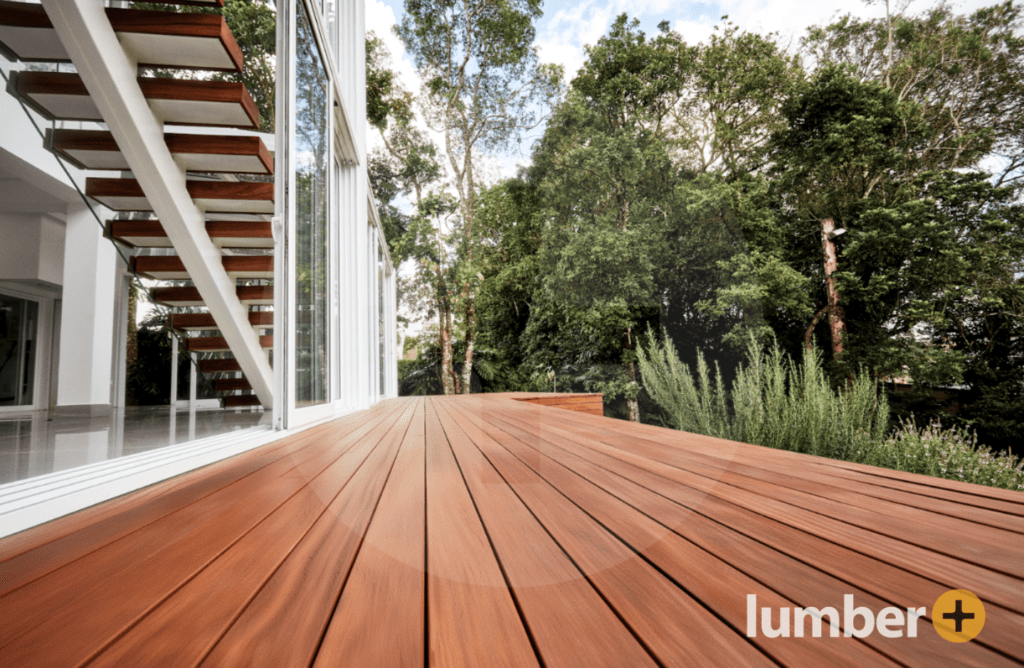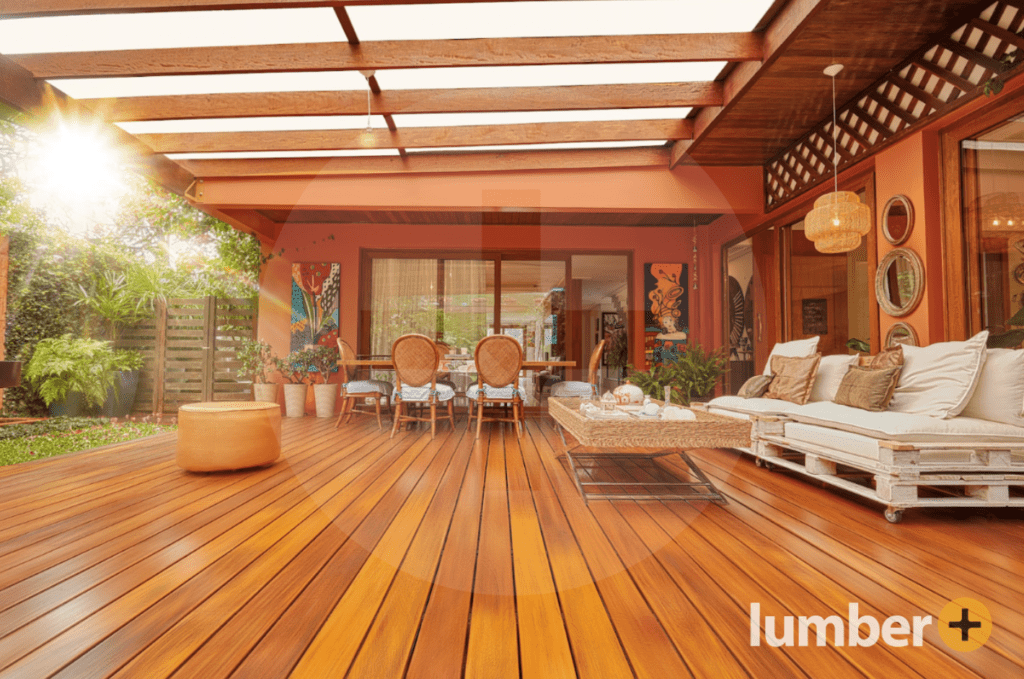When considering decking and siding options, Cumaru and Ipe are two of the most popular choices among homeowners, DIY builders, and contractors.
Known for their durability, aesthetics, and resilience, both wood types have unique advantages.
But in this article, we’re taking a closer look at the differences between Cumaru vs Ipe decking.
Are you ready to get started?
Introduction to Ipe and Cumaru
Let’s start by getting a quick understanding of the characteristics of each wood option:
Characteristics of Ipe
Ipe is a tropical hardwood primarily found in Brazil that is extremely hard and durable. The color of Ipe ranges from olive-brown to reddish-brown, which makes it a visually appealing choice for various applications.
Characteristics of Cumaru
Cumaru, also known as Brazilian Teak, is another tropical hardwood that grows throughout South America. This wood features a medium to dark brown heartwood with a reddish or purplish hue.
Detailed Comparison

Hardness and Density Comparison
Ipe and Cumaru are both exceptionally hard woods, which makes them ideal for high-traffic areas. Ipe has a Janka hardness rating of 3,680 lbf, slightly higher than Cumaru’s 3,540 lbf, which means Ipe is somewhat more resistant to dents and scratches.
In terms of density, Ipe weighs about 69 lbs. per cubic foot, while Cumaru is slightly lighter at 68 lbs. per cubic foot.
Durability and Maintenance Needs
Both Ipe and Cumaru are highly resistant to pests, rot, and decay, making them suitable for outdoor use. However, Ipe has a slight edge in overall strength and longevity because it has a lifespan of up to 75 years if properly maintained. Cumaru, while still durable, has a slightly shorter lifespan and may require more frequent maintenance.
Regular cleaning and sealing are essential for maintaining the appearance and durability of both types of wood.
Ipe and Cumaru can age beautifully to a silver-gray patina if left untreated, that adds a unique aesthetic to outdoor spaces.
Visual Appeal and Texture
Ipe’s color ranges from olive-brown to reddish-brown, with a fine texture and medium luster. Cumaru, on the other hand, has a richer reddish-brown hue with a coarse texture and a waxy feel. Both woods feature interlocked grains that can add a distinctive look to any project.
Ipe’s fine texture and elegant appearance, however, make it a preferred choice for high-end projects, while Cumaru’s vibrant color and robust texture can create a unique and bold aesthetic.
Cost Comparison
Cost is a significant factor when choosing between Cumaru and Ipe.
Generally speaking, Ipe is more expensive, and this is reflected in its higher durability and longer lifespan.
On the other hand, Cumaru is typically less expensive, making it a cost-effective alternative. However, Ipe can be more economical in the long run.
Pros and Cons of Ipe and Cumaru
To keep it simple, here’s a quick list of the pros and cons of Ipe vs Cumaru:
Ipe Pros
- Extremely durable and long-lasting
- High resistance to pests, rot, and decay
- Beautiful fine texture and color variations
- Low maintenance requirements
Ipe Cons
- Higher initial cost
- Can be challenging to work with due to its hardness
- May require pre-drilling for screws and nails
Cumaru Pros
- Highly durable and resistant to damage
- Rich, vibrant color and robust texture
- More affordable than Ipe
- Suitable for a wide range of applications
Cumaru Cons
- Slightly shorter lifespan than Ipe
- Can be difficult to work with due to its hardness
- May require more frequent maintenance
Best Uses for Ipe and Cumaru

Residential Applications
For residential applications, both Ipe and Cumaru are excellent choices.
Ipe is ideal for backyard decks, garden furniture, and siding, and offers a combination of beauty and resilience. Cumaru is also suitable for these applications and provides a slightly different aesthetic with its rich, warm tones.
Commercial Applications
In commercial settings, Ipe’s durability makes it the preferred choice for high-traffic areas like public boardwalks and outdoor seating. Its long lifespan and low maintenance requirements make it a cost-effective solution for commercial projects.
Industrial Applications
For industrial applications, both woods are used in heavy-duty flooring and marine environments. Cumaru’s hardness and density make it suitable for docks and railroad ties, while Ipe’s superior strength and resistance are advantageous for structural components.
Creative Design Ideas

Decking Projects
Combining Ipe and Cumaru in decking projects can create a unique and visually striking design.
Using Ipe for railings and Cumaru for flooring can provide a beautiful contrast of colors and textures that enhances the overall aesthetic of your outdoor space.
Siding Projects
For siding, Ipe can be used for vertical cladding, while Cumaru can create horizontal accents for a dynamic exterior design. The rich colors and interlocked grains of both types of wood can add depth and character to any building facade.
Application-Based Comparison Chart
Alt Text: an image of a Cumaru vs Ipe comparison chart
Choose Lumber Plus for Responsibly-Sourced Ipe and Cumaru

Partner with Lumber Plus for premium-quality Ipe and Cumaru wood products.
Our extensive range of decking and siding options allows you to find the perfect solution for your project.
Contact us today for more information!







